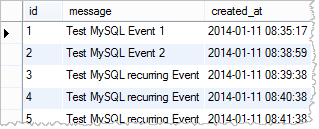In this tutorial, you will learn about MySQL event scheduler and how to create MySQL events to automate database tasks.
A MySQL event is a task that runs based on a predefined schedule therefore sometimes it is referred to as a scheduled event. MySQL event is also known as “temporal trigger” because it is triggered by time, not by table update like a trigger. A MySQL event is similar to a cron job in UNIX or a task scheduler in Windows.
You can use MySQL events in many cases such as optimizing database tables, cleaning up logs, archiving data, or generate complex reports during off-peak time.
MySQL event scheduler configuration
MySQL uses a special thread called event schedule thread to execute all scheduled events. You can see the status of event scheduler thread by executing the following command:
SHOW PROCESSLIST;
By default, the event scheduler thread is not enabled. To enable and start the event scheduler thread, you need to execute the following command:
SET GLOBAL event_scheduler = ON;
Now to see the status of event scheduler thread, you execute the SHOW PROCESSLIST command again.
SHOW PROCESSLIST;
To disable and stop the event the event scheduler thread, you execute the SET GLOBAL command with value of the event_scheduler is OFF:
SET GLOBAL event_scheduler = OFF;
Creating new MySQL events
Creating an event is similar to creating other database objects such as stored procedures or triggers. An event is a named object that contains SQL statements.
A stored procedure is only executed when it is invoked directly; a trigger is executed when an event associated with a table such as insert, update, or delete event occurs, while an event can be executed at once or more regular intervals.
To create and schedule a new event, you use the CREATE EVENT statement as follows:
CREATE EVENT [IF NOT EXIST] event_name ON SCHEDULE schedule DO event_body
Let’s examine the statement in more detail.
First, you specify the event name after the
CREATE EVENTclause. The event name must be unique within a database schema.Second, you put a schedule after the
ON SCHEDULEclause. If the event is a one-time event, you use the syntax:AT timestamp [+ INTERVAL]. If the event is a recurring event, you use theEVERYclause:EVERY interval STARTS timestamp [+INTERVAL] ENDS timestamp [+INTERVAL].Third, you place the SQL statements after the
DOkeyword. It is important to notice that you can call a stored procedure inside the body of the event. In case you have compound SQL statements, you can wrap them in aBEGIN ENDblock.
Let’s look at few examples of creating events to understand the syntax above.
To create and schedule a new one-time event that inserts a message into a table called messages you do the following steps:.
First, create a new table named messages by using the CREATE TABLE statement as follows:
CREATE TABLE IF NOT EXISTS messages ( id INT PRIMARY KEY AUTO_INCREMENT, message VARCHAR(255) NOT NULL, created_at DATETIME NOT NULL );
Second, create an event by using the CREATE EVENT statement:
CREATE EVENT IF NOT EXISTS test_event_01 ON SCHEDULE AT CURRENT_TIMESTAMP DO INSERT INTO messages(message,created_at) VALUES('Test MySQL Event 1',NOW());Third, check the messages table; you will see that we have 1 record. It means the event was executed when it is created.
SELECT * FROM messages;
To shows all events of a database schema, you use the following statement:
SHOW EVENTS FROM classicmodels;
We don’t see any row returned because an event is automatically dropped when it is expired. In our case, it is one-time event and expired when its execution completed.
To change this behavior, you can use the ON COMPLETION PRESERVE clause. The following statement creates another one-time event that is executed after its creation time 1 minute and not dropped after execution.
CREATE EVENT test_event_02 ON SCHEDULE AT CURRENT_TIMESTAMP + INTERVAL 1 MINUTE ON COMPLETION PRESERVE DO INSERT INTO messages(message,created_at) VALUES('Test MySQL Event 2',NOW());Wait for 1 minute, check the messages table, another record was added:
SELECT * FROM messages;
If we execute the SHOW EVENTS statement again, we see the event is there because the effect of the ON COMPLETION PRESERVE clause:
SHOW EVENTS FROM classicmodels;
The following statement creates a recurring event that executes every minute and is expired in 1 hour from its creation time:
CREATE EVENT test_event_03 ON SCHEDULE EVERY 1 MINUTE STARTS CURRENT_TIMESTAMP ENDS CURRENT_TIMESTAMP + INTERVAL 1 HOUR DO INSERT INTO messages(message,created_at) VALUES('Test MySQL recurring Event',NOW());Notice that we used STARTS and ENDS clauses to define expiration period for the event. You can test this recurring event by waiting for few minutes and check the messages table.
SELECT * FROM messages;
Drop MySQL events
To remove an existing event, you use the DROP EVENT statement as follows:
DROP EVENT [IF EXIST] event_name;
For example, to drop the test_event_03 event, you use the following statement:
DROP EVENT [IF EXIST] test_event_03;
In this tutorial, you have learned about MySQL events, how to create and delete events from a database schema. In the next tutorial, we will show you how to change existing event.
Related Tutorials
共同学习,写下你的评论
评论加载中...
作者其他优质文章









